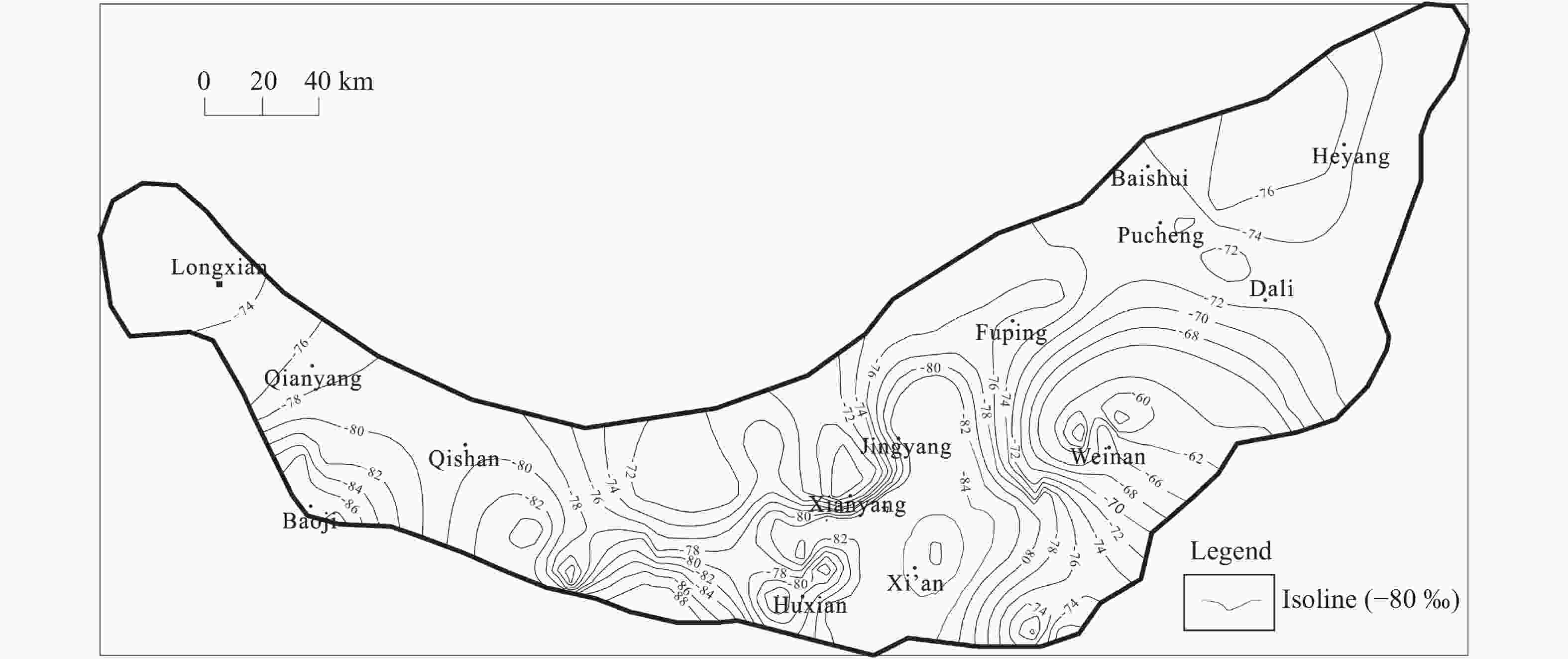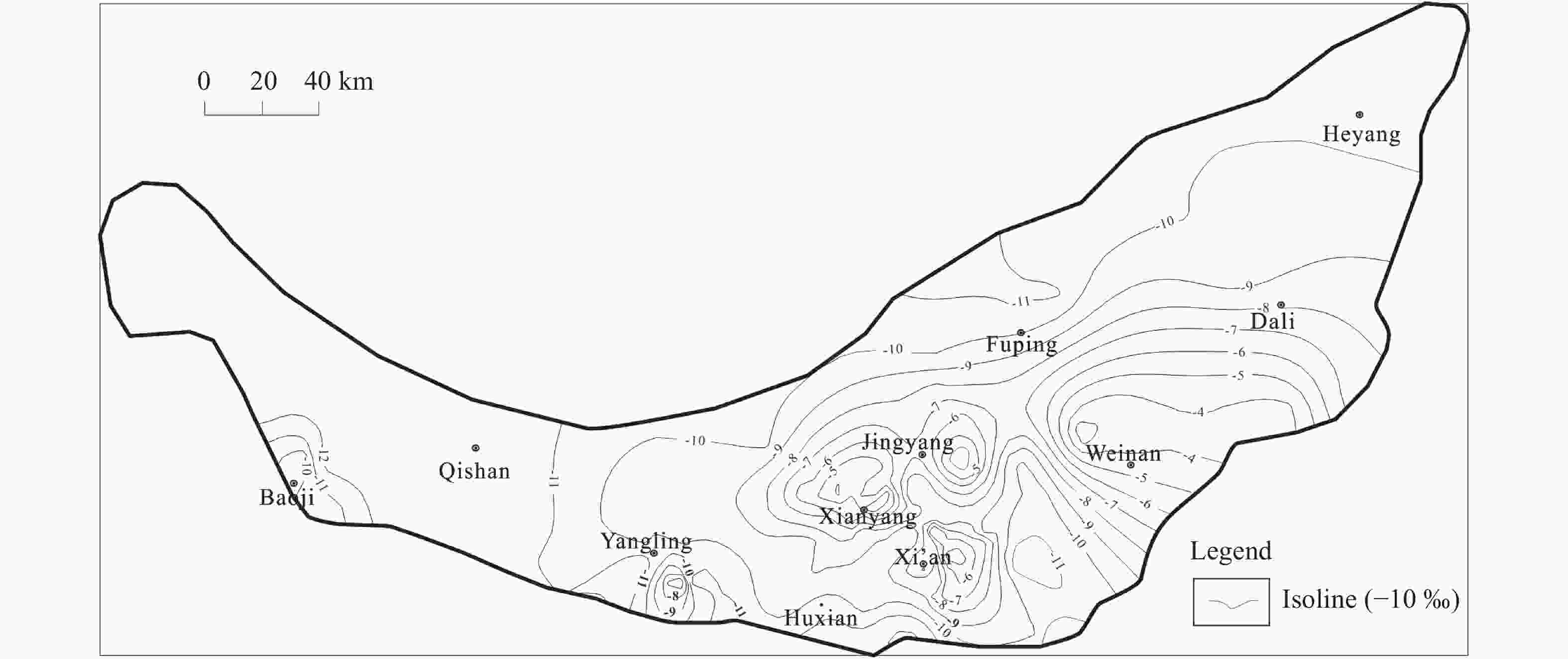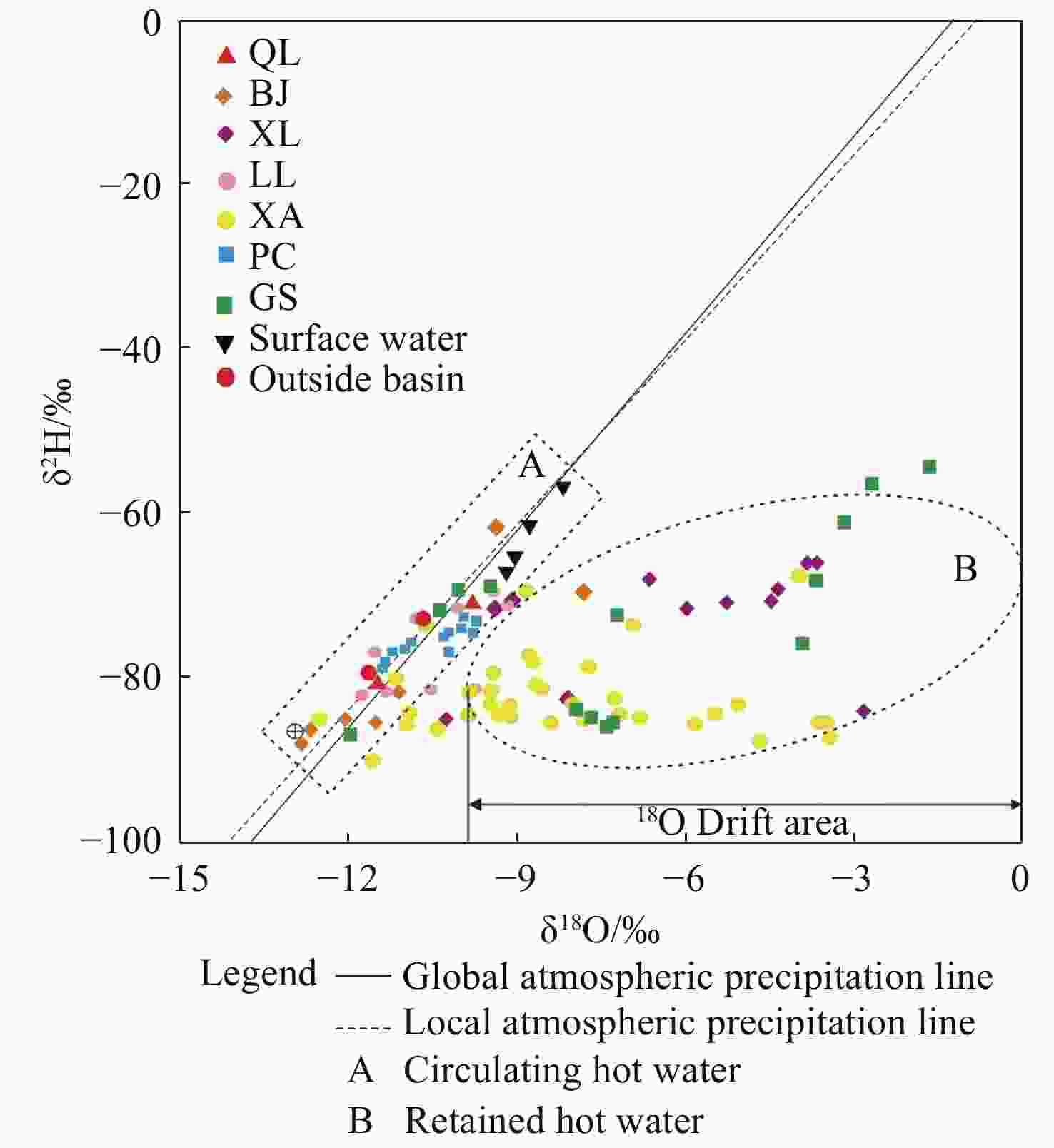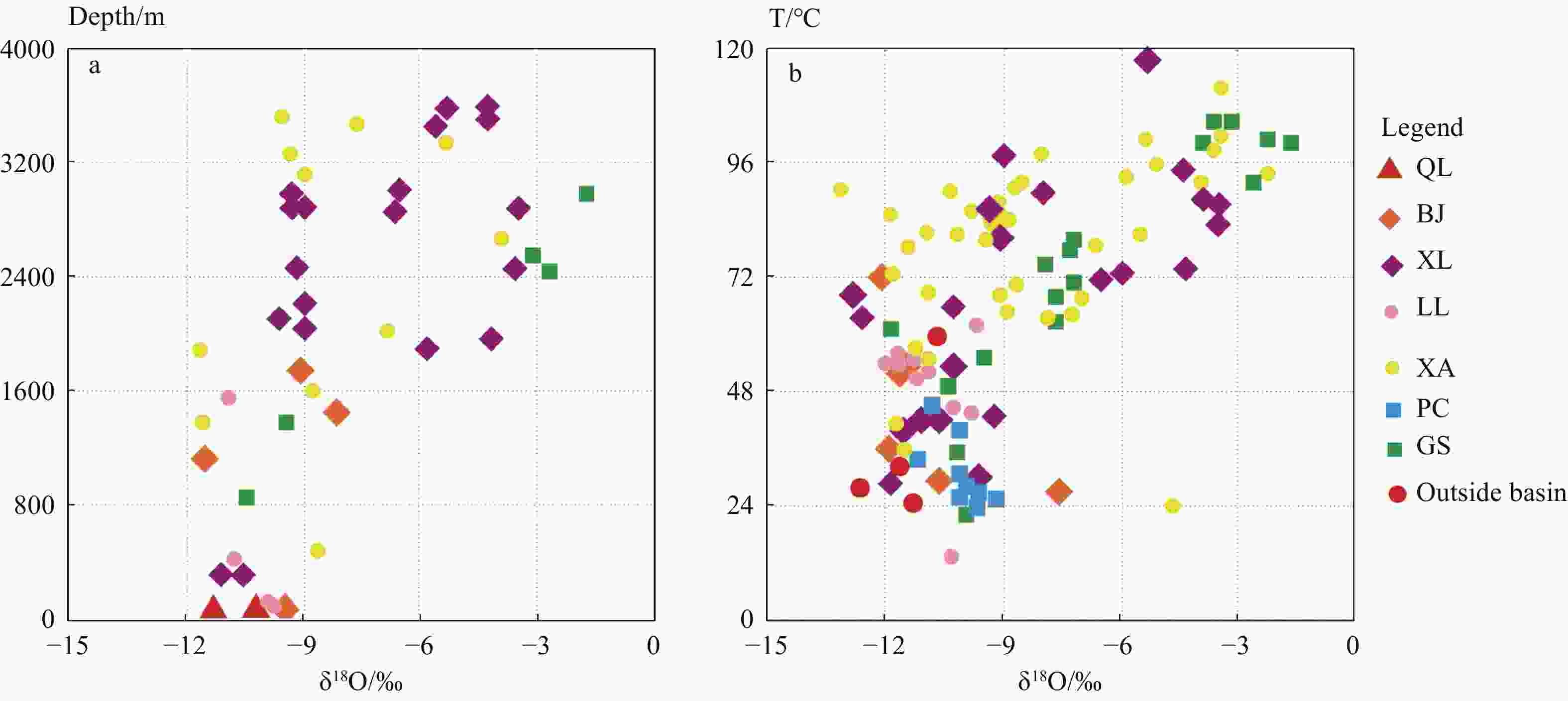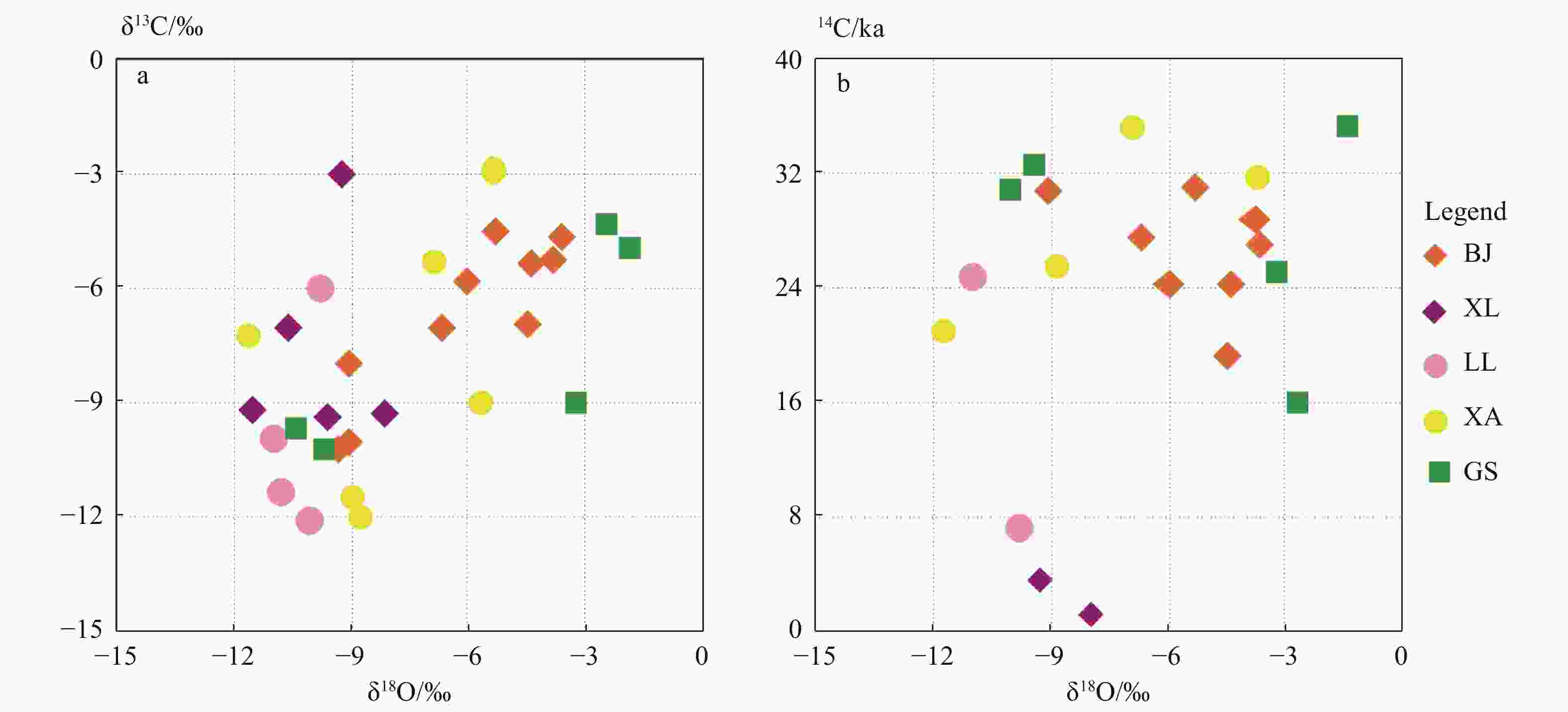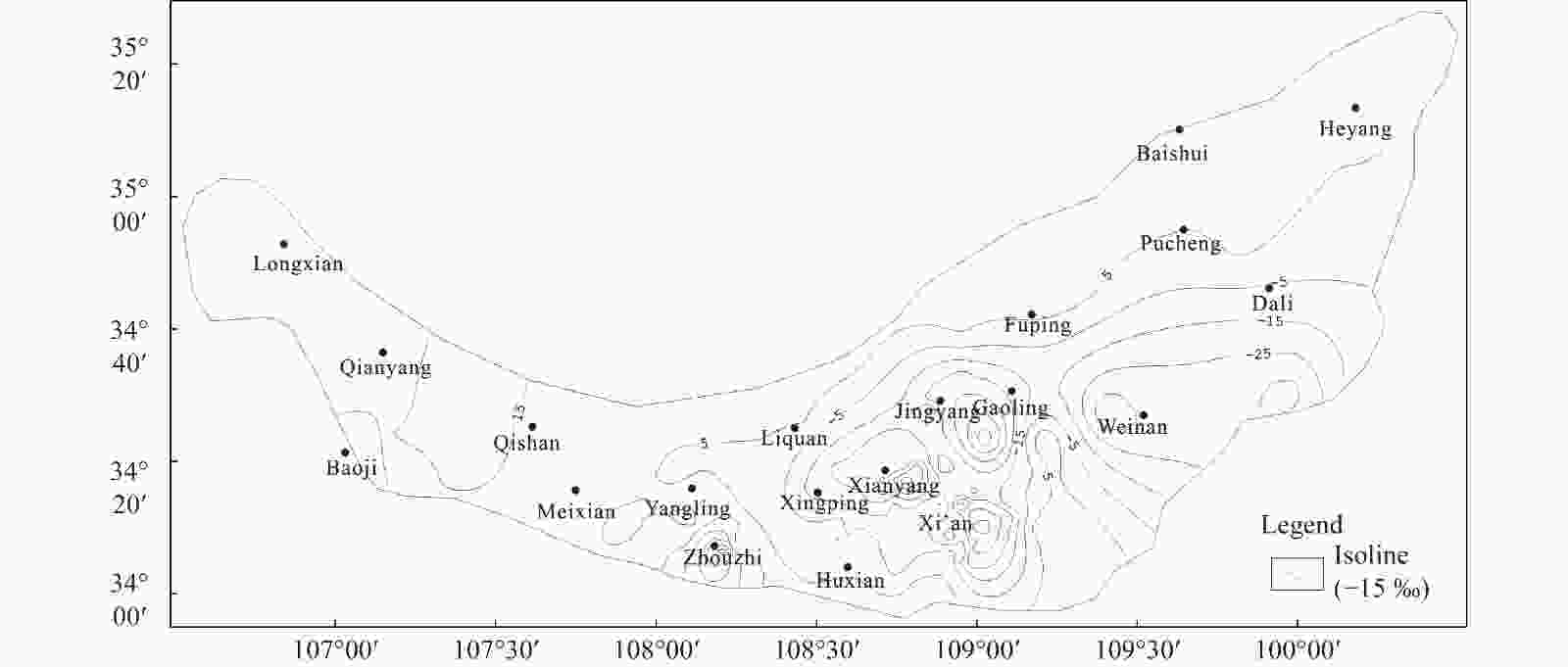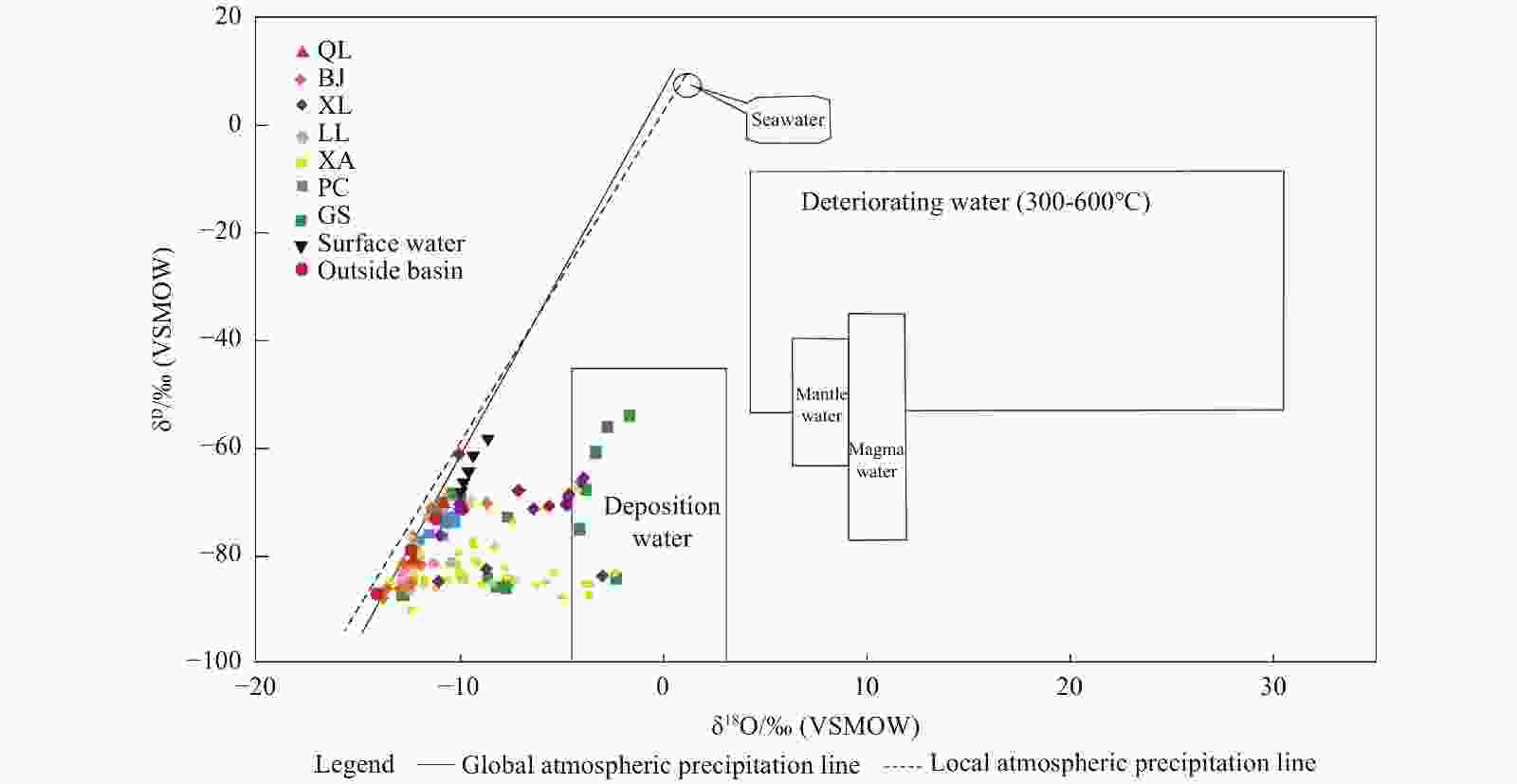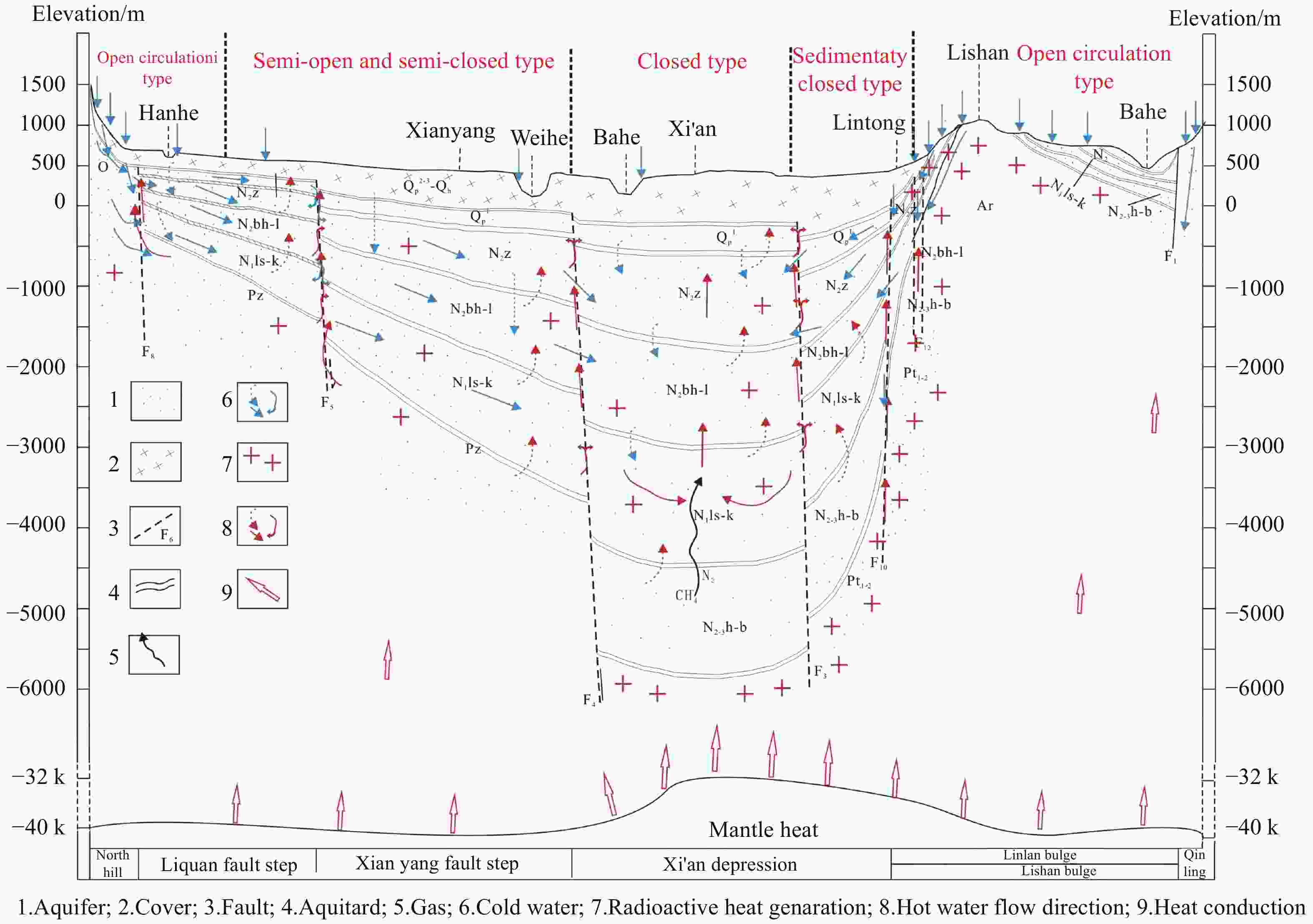Indication of hydrogen and oxygen stable isotopes on the characteristics and circulation patterns of medium-low temperature geothermal resources in the Guanzhong Basin, China
-
Abstract: Guanzhong Basin is a typical medium-low temperature geothermal field mainly controlled by geo-pressure in the west of China. The characteristics of hydrogen and oxygen isotopes were used to analyze the flow and storage modes of geothermal resources in the basin. In this paper, the basin was divided into six geotectonic units, where a total of 121 samples were collected from geothermal wells and surface water bodies for the analysis of hydrogen-oxygen isotopes. Analytical results show that the isotopic signatures of hydrogen and oxygen throughout Guanzhong Basin reveal a trend of gradual increase from the basin edge areas to the basin center. In terms of recharge systems, the area in the south edge belongs to the geothermal system of Qinling Mountain piedmont, while to the north of Weihe fault is the geothermal system of North mountain piedmont, where the atmospheric temperature is about 0.2℃-1.8℃ in the recharge areas. The main factors that affect the geothermal water δ18O drifting include the depth of geothermal reservoir and temperature of geothermal reservoir, lithological characteristics, water-rock interaction, geothermal reservoir environment and residence time. The δ18O-δD relation shows that the main source is the meteoric water, together with some sedimentary water, but there are no deep magmatic water and mantle water which recharge the geothermal water in the basin. Through examining the distribution pattern of hydrogen-oxygen isotopic signatures, the groundwater circulation model of this basin can be divided into open circulation type, semi-open type, closed type and sedimentary type. This provides some important information for rational exploitation of the geothermal resources.
-
Key words:
- Guanzhong Basin /
- Hydrogen-oxygen isotopes /
- Storage characteristics /
- Circulation model
-
Table 1. The result of hydrogen-oxygen stable isotopes in study area
Sample NO. Depth Temperature pH δD/‰ δ18O/‰ Sample NO. Depth Temperature pH δD/‰ δ18O/‰ Surface water q014 1 672.08 66 8.57 –79.42 –11.25 R001 - 17.5 7.63 –61.24 –8.87 q031 2 850 88 8.22 –84.63 –9.17 R005 - 17.5 7.38 –57.1 –8.28 q035 496.8 68.3 8.76 –84.93 –12.52 R007 - 17.5 7.83 –66.92 –9.14 q036 573 49.6 8.66 –82.57 –11.43 R008 - 17.5 7.53 –68.4 –9.28 q037 1 360 57 8.32 –80.02 –11.18 R009 - 17.5 7.47 –65.1 –9.05 q039 1 500 54 8.86 –84.01 –11.4 Outside basin q043 2 402 23.5 8.35 –87.71 –4.73 q008 580 45 8.23 –86.51 –12.9 q045 2 700 96 8.32 –83.28 –5.12 q041 250.27 58.2 8.02 –73.51 –10.61 q046 3 000 91 8.36 –78.1 –8.72 q042 530 43 8.31 –78.92 –11.38 q048 1 750 69 8.15 –82.36 –7.27 q056 648.08 33.7 8.34 –78.44 –11.51 q057 2 685.3 80 7.9 –79.57 –9.44 Baoji bulging(BJ) q058 2 905.3 86 7.88 –81.62 –9.84 q006 28.9 7.55 –71.46 –10.62 q060 1 450 55 7.94 –83.89 –11.46 q009 1 462 46 8.39 –82.24 –11.9 q075 1 650 85 8.88 –85.02 –11.92 q015 2 470 53 7.85 –85.23 –11.47 q077 2 000.2 65 8.26 –84.48 –9.34 q028 1 602.6 51.2 8.56 –85.54 –11.65 q078 2 731.86 80 8.11 –84.74 –6.85 q029 350.5 72 8.39 –86.34 –12.06 q079 3 479.35 112 8.39 –85.29 –3.48 q033 450.5 64 8.87 –86.2 –12.65 q083 3 000 93 8.58 –85.64 –5.89 q034 282 68 8.77 –88.06 –12.82 q084 3 015.9 98 8.68 –83.19 –8.05 q071 - 29 8.27 –81.88 –11.85 q090 1 601.9 65 7.77 –84.38 –7.22 S001 1 450 29 8.32 –70.4 –8.1 q091 1 958 69.5 8.41 –77.24 –8.81 S002 1 114.35 39.2 8.27 –76.8 –11.5 q092 3 558 94 7.65 –84.07 –2.3 S003 400.18 41.5 8.16 –81.8 –11.1 q094 3 355 102 7.81 –87.3 –3.48 S004 400 41.5 8.32 –72.3 –10.6 q095 2 658 92 8.3 –81.41 –8.56 S005 Spring 30 8.36 –69 –9.6 q096 2 003.17 52 8.64 –83.5 –11.44 S015 1253 47 8.25 –70.8 –9.2 q097 2 211.8 81 8.15 –84.45 –10.22 Xianli fault-step(XL) q098 2 651.7 99 8.46 –85.17 –3.65 q030 3 050 90 7.98 –82.6 –8.08 q099 2 500 8.47 –83.5 –9.18 q080 2 700 70 7.83 –85 –7.8 S014 1 450 40 8.23 –76.6 –11.611 q086 2 800 90 8.28 –85.95 –10.41 Pucheng bulging(PC) q087 2 105.8 65 7.96 –85.07 –10.3 q016 169 29.5 8.2 –74.92 –9.79 q088 1 901.68 53 7.65 –76.45 –10.24 q017 160 27.5 8.17 –73.22 –9.72 q093 2 975 90 7.71 –83.9 –2.85 q018 150 27.8 8.08 –73.16 –9.77 S008 2 787 71 8.03 –68.1 –6.7 q019 210 28.6 8.16 –72.66 –10 S020 1 751 72 8.14 –71.6 –6 q020 300 41 7.79 –75.6 –10.25 S022 2 471 90 7.95 –66.3 –3.8 q021 520 27 8.1 –74.16 –10.01 S023 3 553 94 7.89 –70.6 –4.5 q022 2 000 63 8.23 –87.78 –9.87 S024 2 000 74 8.31 –69.3 –4.4 q023 651.8 25.5 8.33 –69.47 –9.37 S025 2 818 89 8.03 –66 –3.7 q024 270 26 8.32 –69.12 –9.72 S028 3 500.3 120 7.96 –71 –5.3 q025 430 28 7.68 –73.06 –10.14 S029 2 905.3 86 7.88 –71.5 –9.34 q026 2 452 75 8.16 –83.59 –7.98 S030 2 013 80 8.15 –70.8 –9.07 q049 651.5 28 8.22 –74.11 –10.23 Linlan bulging(LL) q050 1 050 33 8.13 –77.17 –11.26 q027 2 625.5 63 8.34 –81.22 –9.75 q051 778.3 42 8.16 –75.99 –10.86 q032 1 500 56 8.81 –85.01 –12.03 q073 2 600 105 7.3 –68.23 –3.69 q038 1 772 56 8.78 –84.58 –11.61 q085 2 857.8 96 8.64 –84.09 –9.36 q040 2 060 79 8.41 –85.85 –11.6 q089 800 35 7.74 –76.81 –10.2 q052 854.3 49 8.68 –78.74 –11.36 Gushi depression(GS) q053 10.7 44.6 8.33 –72.36 –10.46 q001 2 470 71 8.41 –85.23 –7.23 q055 2 136.9 52 8.34 –81.48 –10.54 q002 2 403 78 7.98 –85.93 –7.32 q061 455.9 54.5 8.76 –76.4 –10.94 q003 2 341 68 8.13 –85.4 –7.67 q062 652.8 58 8.92 –82.27 –11.74 q004 2 790 80 7.31 –72.37 –7.25 q072 1 012.6 53 8.73 –83.25 –11.99 q007 22.1 8.16 –69.68 –10 q076 1 985 55 8.56 –81.65 –11.34 q044 2 870 100 8 –75.41 –3.96 q100 3 230 81 8.05 –85.14 –5.53 q059 1 669.7 61.5 8.76 –87.02 –11.92 S006 Spring 11 - –71.3 –10.1 q069 3 258.7 63 7.94 –85.06 –7.66 S007 Spring 43 - –69.1 –9.8 q070 3 200 101 7.5 –84.45 –2.3 S018 460 55 - –72.9 –10.8 S009 3 008.9 100 - –54.5 –1.7 S019 1 550 50 - –76.2 –11 S010 2451 92 - –56.4 –2.7 Xi’an Depression(XA) S011 2600 105 - –61.1 –3.21 q005 2100 35.2 8.83 –85.01 –11.68 S012 854 49.5 - –71.9 –10.4 q010 3 258.7 92 8.63 –85.37 –8.41 S013 1 500.3 55 - –68.9 –9.5 q011 2 096 81.5 8 –85.43 –10.99 Qinling(QL) q012 2 436.5 52 8.6 –84.32 –10.94 S041 0 16 7.83 –71 –9.9 q013 3 005 80 8.53 –83.08 –9.4 S042 0 16 7.52 –81 –11.4 -
Chandrajith R, Barth JAC, Subasinghe ND, et al. 2013. Geochemical and isotope characterization of geothermal spring waters in Sri Lanka: Evidence for steeper than expected geothermal gradients. Journal of Hydrology, 476: 360-369. doi: 10.1016/j.jhydrol.2012.11.004 Clayton RN, Steiner A. 1975. Oxygen isotope studies of the geothermal system at Wairakei, New Zealand. Geochimicaet Cosmochimica Acta, 39(8): 1179-1186. doi: 10.1016/0016-7037(75)90059-9 Craig H. 1961. Isotopic variations in meteoric waters. Science, 133(3465): 1702-1703. doi: 10.1126/science.133.3465.1702 Craig H. 1966. Isotopic composition and origin of the Red Sea and Salton Sea geothermal brines. Science, 154(3756): 1544-1548. doi: 10.1126/science.154.3756.1544 Dansgaard W. 1964. Stable isotopes in precipitation. Tellus, 15(4): 436-468. Diamond RE, Harris C. 2000. Oxygen and hydrogen isotope geochemistry of thermal springs of the Western Cape, South Africa: Recharge at high altitude? Journal of African Earth Sciences, 31(3): 467-481. Dotsika E, Poutoukis D, Raco B. 2010. Fluid geochemistry of the Methana Peninsula and Loutraki geothermal area, Greece. Journal of Geochemical Exploration, 104(3): 97-104. doi: 10.1016/j.gexplo.2010.01.001 Dotsika E. 2012. Isotope and hydrochemical assessment of the Samothraki Island geothermal area. Journal of Volcanology and Geothermal Research, 233-234: 18-26. doi: 10.1016/j.jvolgeores.2012.04.017 Giggenbach WF, Glover RB. 1992. Tectonic regime and major processes governing the chemistry of water and gas discharges from the Rotorua geothermal field, New Zealand. Geothermics, 21(1-2): 121-140. doi: 10.1016/0375-6505(92)90073-I Guo Q, Pang ZH, Wang YC, et al. 2017. Fluid geochemistry and geothermometry applications of the Kangding high-temperature geothermal system in Eastern Himalayas. Applied Geochemistry, 81: 63-75. doi: 10.1016/j.apgeochem.2017.03.007 Hu Y, Ma ZY, Yu J, et al. 2009. Estimation of the making-up temperature of geothermy water and the thermal reservoir temperature in Guanzhong Basin. Journal of Earth Sciences and Environment, 31(02): 173-176. Jiao T, Zpab C, YwabC, et al. 2019. Fluid geochemistry of the Cuopu high temperature geothermal system in the eastern Himalayan syntaxis with implication on its genesis. Applied Geochemistry, 110: 104422. doi: 10.1016/j.apgeochem.2019.104422 Jiang G, Gao P, Rao S, et al. 2017. Compilation of heat flow data in the continental area of China (4th edition). Chinese journal of geophysics-chinese edition, 59(7): 2892-2910. Komatsu S, Okano O, Ueda A. 2021. Chemical and isotopic (H, O, S, and Sr) analyses of groundwaters in a non-volcanic region, Okayama prefecture, Japan: Implications for geothermal exploration. Geothermics, 91: 102005. doi: 10.1016/j.geothermics.2020.102005 Li XC, Ma ZY, Zhang XL, et al. 2016. Genetic model of the Dongda geothermal field in Guanzhong Basin, Shaanxi Province. Geology in China, 43(06): 2082-2091. Liu F, Jin H, Mu G. 2009. Investigation and evaluation report of geothermal resources in Guanzhong Basin. Shaanxi Province. Xi’an: Shaanxi Institute of Geo-Environment Monitoring. Luo L, Pang ZH, Liu JX, et al. 2017. Determining the recharge sources and circulation depth of thermal waters in Xianyang geothermal fifield in Guanzhong Basin: The controlling role of Weibei Fault. Geothermics, 69: 55-64. Majumdar N, Majumdar RK, Mukherjee AL, et al. 2005. Seasonal variations in the isotopes of oxygen and hydrogen in geothermal waters from Bakreswar and Tantloi, Eastern India: Implications for groundwater characterization. Journal of African Earth Sciences, 25(2): 269-278. Majumdar N, Mukherjee AL, Majumdar RK. 2009. Mixing hydrology and chemical equilibria in Bakreswar geothermal area, Eastern India. Journal of Volcanology and Geothermal Research, 183(3): 201-212. Ma Y. 2007. Water-rock interaction and genesis of low-medium temperature thermal groundwater in carbonate reservoir. China University of Geosciences. Ma ZY, Zhang XL, He D, et al. 2016. A study of 36Cl age for the deep geothermal water in the Guanzhong Basin. Hydrogeology and Engineering Geology, 43(01): 157-163. Ma ZY, Fang JJ, Niu GL, et al. 2006. Classification of thermal water in Guanzhong Area, Shaanxi Province. Coal GeolExplor, 33: 54-58. Ma ZY, Wang XG, Su Y, et al. 2008. Oxygen and hydrogen isotope exchange and its controlling factors in subsurface geothermal waters in the central Guanzhong Basin, Shaanxi, China. Geological Bulletin of China, 27(06): 888-894. Pang ZH, Fan ZC, Wang JX. 1990. The study on stable oxygen and hydrogen isotopes in the Zhangzhou Basin hydrothermal system. Acta Petrol Sin, 11(04): 75-84. Pinti DL, Castro MC, Shoaukar-Stash O, et al. 2013. Evolution of the geothermal fluids at Los Azufres, Mexico, as traced by noble gas isotopes, δ18O, δD, δ13C and 87Sr/86Sr. Volcanology and Geothermal Research, 249: 1-11. doi: 10.1016/j.jvolgeores.2012.09.006 Pinti D L, Shouakar-Stash O, Castro M C, et al. 2020. The bromine and chlorine isotopic composition of the mantle as revealed by deep geothermal fluids. Geochimica et Cosmochimica Acta, 276: 14-30. doi: 10.1016/j.gca.2020.02.028 Qin DJ, Pan ZH, Turner JV, et al. 2005. Isotopes of geothermal water in Xi’an area and implications on its relation to karstic groundwater in North Mountains. Acta Petrologica Sinica, 21(05): 1489-1500. Richard L, Pinti D L, Helie J F, et al. 2019. Variability of deep carbon sources in Mexican geothermal fluids. Journal of Volcanology & Geothermal Research, 370(1): 1-12. Singh P, Mukherjee S. 2019. Chemical signature detection of groundwater and geothermal waters for evidence of crustal deformation along fault zones. Journal of Hydrology, 582(4): 124459. Sun HL, Ma F, Liu Z, et al. 2015. The distribution and enrichment characteristics of fluoride in geothermal active area in Tibet. China Environmental Science, 35(01): 251-259. Sun HL, Ma F, Lin WJ, et al. 2015. Geochemical characteristics and application of geothermal temperature scales of high-temperature geothermal fields in Tibet. GeolSci Tech Inf, 34: 171-177. Sun ZX, Li XL. 2001. Studies of geothermal waters in Jiangxi Province using isotope techniques. Science in China Series E: Technological Sciences, 44(1): 144-150. Tan H, Zhang W, Chen J, et al. 2012. Isotope and geochemical study for geothermal assessment of the Xining basin of the northeastern Tibetan Plateau. Geothermics, 42: 47-55. doi: 10.1016/j.geothermics.2012.01.001 Wang C, Zheng M, Zhang X, et al. 2020. O, H, and Sr isotope evidence for origin and mixing processes of the Gudui geothermal system, Himalayas, China. Geoscience Frontiers, 11: 1175-1187. doi: 10.1016/j.gsf.2019.09.013 Wang GL, Liu ZM, Lin WJ. 2004. Tectonic control of geothermal resources in the peripheral of Ordos Basin. Acta Geologica Sinica, 78(01): 44-51. Wang GL, Zhang W, Liang JY, et al. 2017. Evaluation of geothermal resources potentials in China. Acta Geoscientica Sinica, 38(4): 449-459. Wang J. 1996. Low-temperature convection geothermal system. Earth Sci Front., 3: 96-100. Wang JX, Huang SP. 1989. Statistical analysis of continental heat flow data from China. Chinese Science Bulletin, 34(07): 582-587. Yan H, Ma Z, Li T, et al. 2012. Environmental isotope hydrogeochemical characteristics and instructions of geothermal water in Xianyang Urban Area. Advanced Materials Research, 1793: 4161-4164. Yao TD, Xu BQ, Pu JC. 2001. Temperature changes of orbital and sub-orbital time scales recorded in the Guliya Ice Core on the Qinghai-Tibetan Plateau. Science in China (Series D), 31: 288-294. Zhang S. 1989. Study of the hydrogen-oxygen isotope composition characteristics of modern atmospheric precision in Shaanxi Province. Shaanxi Geology, 7: 57-66. -

 E-mail alert
E-mail alert Rss
Rss


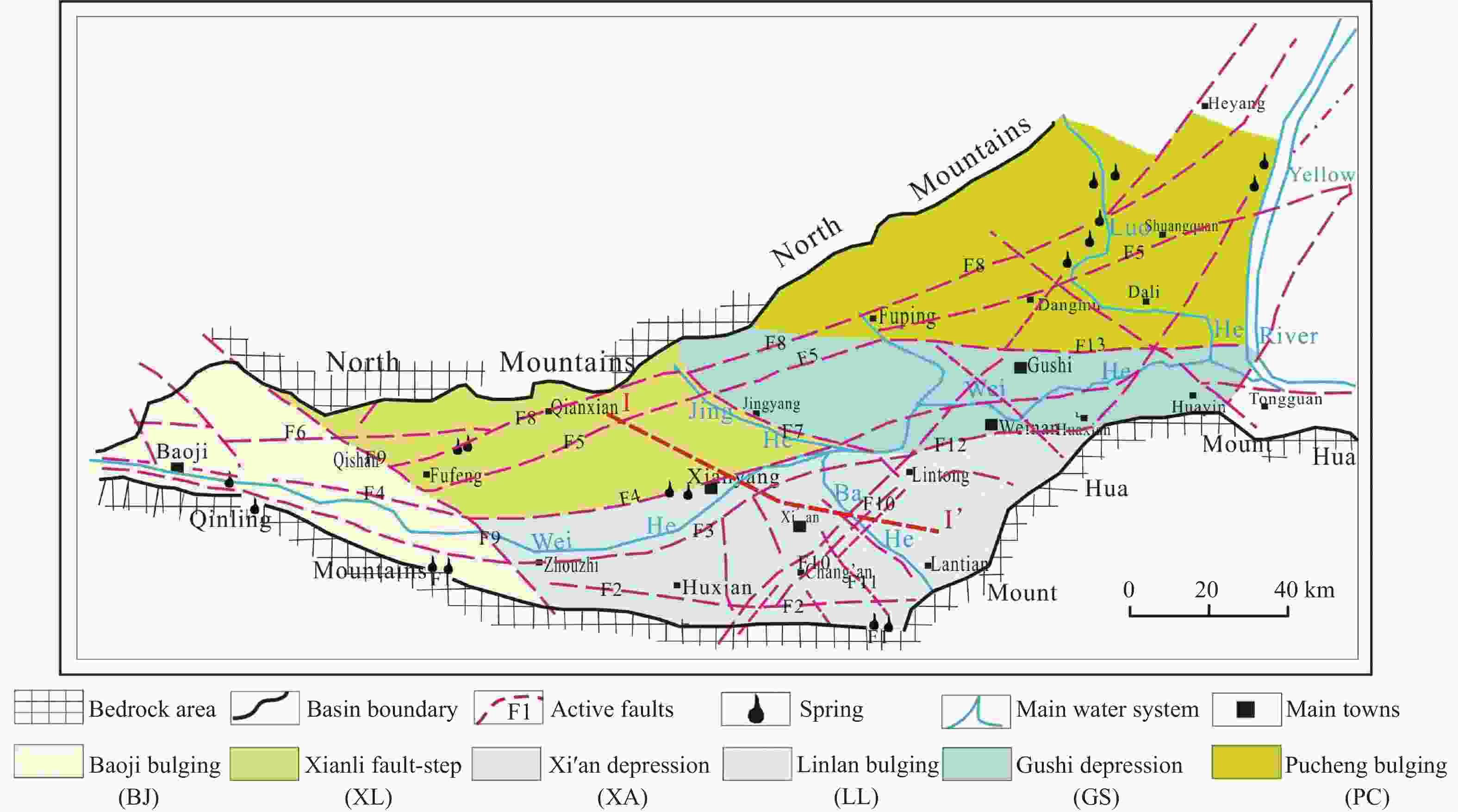
 下载:
下载:

